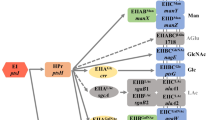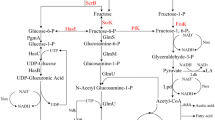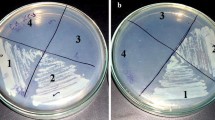Abstract
Phosphomannose isomerases (PMIs) in bacteria and fungi catalyze the reversible conversion of d-fructose-6-phosphate to d-mannose-6-phosphate during biosynthesis of GDP-mannose, which is the main intermediate in the mannosylation of important cell wall components, glycoproteins, and certain glycolipids. In the present study, the kinetic parameters of PMI from Streptomyces coelicolor were obtained, and its function on antibiotic production and sporulation was studied. manA (SCO3025) encoding PMI in S. coelicolor was deleted by insertional inactivation. Its mutant (S. coelicolor∆manA) was found to exhibit a bld-like phenotype. Additionally, S. coelicolor∆manA failed to produce the antibiotics actinorhodin and red tripyrolle undecylprodigiosin in liquid media. To identify the function of manA, the gene was cloned and expressed in Escherichia coli BL21 (DE3). The purified recombinant ManA exhibited PMI activity (K cat/K m (mM−1 s−1 = 0.41 for d-mannose-6-phosphate), but failed to show GDP-d-mannose pyrophosphorylase [GMP (ManC)] activity. Complementation analysis with manA from S. coelicolor or E. coli resulted in the recovery of bld-like phenotype of S. coelicolor∆manA. SCO3026, another ORF that encodes a protein with sequence similarity towards bifunctional PMI and GMP, was also tested for its ability to function as an alternate ManA. However, the purified protein of SCO3026 failed to exhibit both PMI and GMP activity. The present study shows that enzymes involved in carbohydrate metabolism could control cellular differentiation as well as the production of secondary metabolites.
Access this article
We’re sorry, something doesn't seem to be working properly.
Please try refreshing the page. If that doesn't work, please contact support so we can address the problem.





Similar content being viewed by others
References
Abu-Qarn M, Eichler J, Sharon N (2008) Not just for Eukarya anymore: protein glycosylation in Bacteria and Archaea. Curr Opin Struct Biol 18:544–550
Amos MR, Sanchez-Contreras M, Jackson RW, Munoz-Berbel X, Ciche TA, Yang G, Cooper RM, Waterfield NR (2011) Influence of the P. luminescens phosphomannose isomerase gene, manA, on mannose utilization, exopolysaccharide structure, and biofilm formation. Appl Environ Microbiol 77:776–785
Baltz RH (1998) Genetic manipulation of antibiotic producing Streptomyces. Trends Microbiol 6:76–83
Bierman M, Logan R, O’Brien K, Seno ET, Rao RN, Schoner BE (1992) Plasmid cloning vectors for the conjugal transfer of DNA from E. coli to Streptomyces spp. Gene 116:43–49
Bystrykh LV, Fernandez-Moreno MA, Herrema JK, Malpartida F, Hopwood DA, Dijkhuizen L (1996) Production of actinorhodin related “blue pigments” by S. coelicolor A3(2). J Bacteriol 178:2238–2244
Cleasby A, Wonacott A, Skarzynski T, Hubbard RE, Davies GJ, Proudfoot AEI, Bernard AR, Payton MA, Wells TNC (1996) The X-ray crystal structure of phosphomannose isomerase from C. albicans at 1.7 Å resolution. Nat Struct Biol 3:470–479
Coulin F, Magnenat E, Proudfoot AE, Payton MA, Scully P, Wells TN (1993) Identification of Cys-150 in the active site of phosphomannose isomerase from C. albicans. Biochemistry 32:14139–14144
Degenhardt J, Poppe A, Montag J, Szankowski I (2006) The use of the phosphomannose-isomerase/mannose selection system to recover transgenic apple plants. Plant Cell Rep 25:1149–1156
Dunwell JM, Khuri S, Gane PJ (2000) Microbial relatives of the seed storage proteins of higher plants: conservation of structure and diversification of function during evolution of the cupin superfamily. Microbiol Mol Biol Rev 64:153–179
Elbaz M, Ben-Yehuda S (2010) The metabolic enzyme ManA reveals a link between cell wall integrity and chromosome morphology. PLoS Genet 6:e1001119
Fang W, Yu X, Wang B, Zhou H, Ouyang H, Ming J, Jin C (2009) Characterization of the A. fumigatus phosphomannose isomerase Pmi1 and its impact on cell wall synthesis and morphogenesis. Microbiology 155:3281–3293
Flärdh K, Buttner MJ (2009) Streptomyces morphogenetics: dissecting differentiation in a filamentous bacterium. Nat Rev Microbiol 7:36–49
Flärdh K, Leibovitz E, Buttner MJ, Chater KF (2000) Generation of a non-sporulating strain of S. coelicolor A3(2) by the manipulation of a developmentally controlled ftsZ promoter. Mol Microbiol 38:737–749
Garami A, Ilg T (2001) The role of phosphomannose isomerase in Leishmania mexicana glycoconjugate synthesis and virulence. J Biol Chem 276:6566–6575
Hansen T, Wendorff D, Schönheit P (2004) Bifunctional phosphoglucose/phosphomannose isomerases from the archaea Aeropyrum pernix and Thermoplasma acidophilum constitute a novel enzyme family within the phosphoglucose isomerase superfamily. J Biol Chem 279:2262–2272
Jensen SO, Reeves PR (1998) Domain organisation in phosphomannose isomerases (type I and II). Biochim Biophys Acta 1382:5–7
Kawamoto S, Watanabe H, Hesketh A, Ensign JC, Ochi K (1997) Expression analysis of the ssgA gene product, associated with sporulation and cell division in S. griseus. Microbiology 143:1077–1086
Keijser BJF, Noens EEE, Kraal B, Koerten HK, van Wezel GP (2003) The S. coelicolor ssgB gene is required for early stages of sporulation. FEMS Microbiol Lett 225:59–67
Kelemen GH, Viollier PH, Tenor J, Marri L, Buttner MJ, Thompson CJ (2001) A connection between stress and development in the multicellular prokaryote S. coelicolor A3(2). Mol Microbiol 40:804–814
Kieser T, Bibb MJ, Buttner MJ, Chater K, Hopwood DA (2000) Practical Streptomyces genetics. John Innes Centre, Norwich
Lamblin F, Aimé A, Hano C, Roussy I, Domon JM, Van Droogenbroeck B, Lainé E (2007) The use of the phosphomannose isomerase gene as alternative selectable marker for Agrobacterium-mediated transformation of flax (Linum usitatissimum). Plant Cell Rep 26:765–772
Lee KW, Joo HS, Yang YH, Song EJ, Kim BG (2006) Proteomics for Streptomyces: “industrial proteomics” for antibiotics. J Microbiol Biotechnol 16:331–348
Lochlainn LN, Patrick Caffrey P (2009) Phosphomannose isomerase and phosphomannomutase gene disruptions in S. nodosus: impact on amphotericin biosynthesis and implications for glycosylation engineering. Metab Eng 11:40–47
McCarthy TR, Torelles JB, MacFarlane AS, Katawczik M, Kutzbach B, DeJardin LE, Clegg S, Goldberg JB, Schlesinger LS (2005) Overexpression of Mycobacterium tuberculosis manB, a phosphomannomutase that increases phosphatidylinositol mannosidebiosynthesis in Mycobacterium smegmatis and mycobacterial association with human macrophages. Mol Microbiol 58:774–790
Ong E, Kilburn DG, Miller RC Jr, Warren RA (1994) Streptomyces lividans glycosylates the linker region of a beta-1,4-glycanase from Cellulomonas fimi. J Bacteriol 176:999–1008
Papoutsopoulou SV, Kyriakidis DA (1997) Phosphomannose isomerase of Xanthomonas campestris: a zinc activated enzyme. Mol Cell Biochem 177:183–191
Pitkänen JP, Törmä A, Alff S, Huopaniemi L, Mattila P, Renkonen R (2004) Excess mannose limits the growth of phosphomannose isomerase PMI40 deletion strain of S. cerevisiae. J Biol Chem 279:55737–55743
Roux C, Bhatt F, Foret J, de Courcy B, Gresh N, Piquemal JP, Jeffery CJ, Salmon L (2011) The reaction mechanism of type I phosphomannose isomerases: new information from inhibition and polarizable molecular mechanics studies. Proteins 79:203–220
Sambrook J, Fritsch E, Maniatis T (1998) Molecular cloning: a laboratory manual, 2nd edn. Cold Spring Harbor Laboratory, Cold Spring Harbor.
Sampaio M, Santos H, Boos W (2003) Synthesis of GDP-mannose and mannosylglycerate from labeled mannose by genetically engineered E. coli without loss of specific isotopic enrichment. Appl Environ Microbiol 69:233–240
Sasaki M, Teramoto H, Inui M, Yukawa H (2011) Identification of mannose uptake and catabolism genes in C. glutamicum and genetic engineering for simultaneous utilization of mannose and glucose. Appl Microbiol Biotechnol 89:1905–1916
Shinabarger D, Berry A, May TB, Rothmel R, Fialho AM, Chakrabarty AM (1991) Purification and characterization of phosphomannose isomerase-guanosine diphospho-d-mannose pyrophosphorylase: a bifunctional enzyme in the alginate biosynthetic pathway of Pseudomonas aeruginosa. J Biol Chem 266:2080–2088
Sílvia Sousa S, Christian Ramos C, Joana Feliciano J, Jorge Leitão J (2010) Bacterial type II PMIs: exploitable bifunctional enzymes for biotechnological applications and the rational design of antimicrobials. In: Elnashar M (ed) Biopolymers. InTech, Rijeka, pp 285–202
Sousa SA, Moreira LM, Wopperer J, Eberl L, Sá-Correia I, Leitão JH (2007) The Burkholderia cepacia bceA gene encodes a protein with phosphomannose isomerase and GDP-D-mannose pyrophosphorylase activities. Biochem Biophys Res Commun 353:200–206
Sthapit B, Oh TJ, Lamichhane R, Liou K, Lee HC, Kim CG, Sohng JK (2004) Neocarzinostatin naphthoate synthase: an unique iterative type I PKS from neocarzinostatin producer Streptomyces carzinostaticus. FEBS Lett 566:201–206
van Heijenoort J (2007) Lipid intermediates in the biosynthesis of bacterial peptidoglycan. Microbiol Mol Biol Rev 71:620–635
Wehmeier S, Varghese AS, Gurcha SS, Tissot B, Panico M, Hitchen P, Morris HR, Besra GS, Dell A, Smith MC (2009) Glycosylation of the phosphate binding protein, PstS, in S. coelicolor by a pathway that resembles protein O-mannosylation in eukaryotes. Mol Microbiol 71:421–433
Wells TN, Coulin F, Payton MA, Proudfoot AE (1993) Phosphomannose isomerase from S. cerevisiae contains two inhibitory metal ion binding sites. Biochemistry 32:294–1301
Wu B, Zhang Y, Zheng R, Guo C, Wang PG (2002) Bifunctional phosphomannose isomerase/GDP-D-mannose pyrophosphorylase is the point of control for GDP-D-mannose biosynthesis in H. pylori. FEBS Lett 519:87–92
Xu D, Seghezzi N, Esnault C, Virolle MJ (2010) Repression of antibiotic production and sporulation in S. coelicolor by overexpression of a TetR family transcriptional regulator. Appl Environ Microbiol 76:7741–7753
Yang YH, Joo HS, Lee K, Liou KK, Lee HC, Sohng JK, Kim BG (2005) Novel method for detection of butanolides in S. coelicolor culture broth, using a His-tagged receptor (ScbR) and mass spectrometry. Appl Environ Microbiol 71:5050–5055
Yang YH, Song E, Park SH, Kim JN, Lee K, Kim E, Kim YG, Kim BG (2010) Loss of phosphomannomutase activity enhances actinorhodin production in S. coelicolor. Appl Microbiol Biotechnol 86:1485–1492
Acknowledgments
This work was supported by WCU program (R322009000102130), Basic Science Research Program (2010–0009942), and Priority Research Centers Program (2009–0094021) through the National Research Foundation (NRF) grant funded by the Korean Government (MEST). This subject is also partially supported by the Korea Ministry of Environment as a “Converging Technology Project (201-101-007)” and the Converging Research Center Program through the National Research Foundation (NRF 2009-0082832).
Author information
Authors and Affiliations
Corresponding author
Additional information
Thangamani Rajesh and Eunjung Song contributed equally to this work.
Rights and permissions
About this article
Cite this article
Rajesh, T., Song, E., Kim, JN. et al. Inactivation of phosphomannose isomerase gene abolishes sporulation and antibiotic production in Streptomyces coelicolor . Appl Microbiol Biotechnol 93, 1685–1693 (2012). https://doi.org/10.1007/s00253-011-3581-z
Received:
Revised:
Accepted:
Published:
Issue Date:
DOI: https://doi.org/10.1007/s00253-011-3581-z




